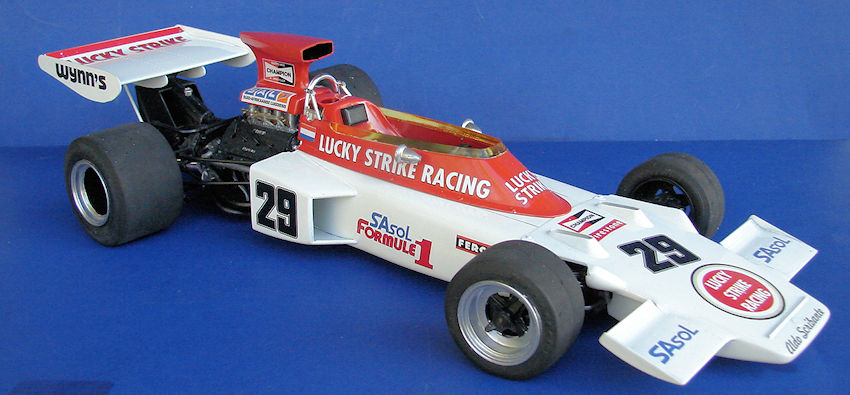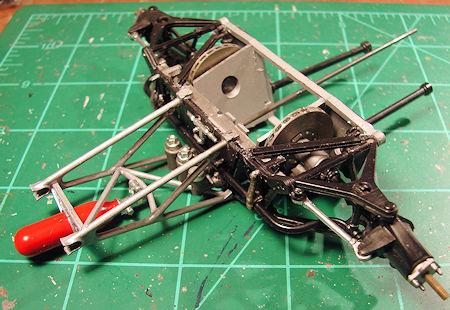
| KIT #: | 12046 |
| PRICE: | $175.00 SRP |
| DECALS: | One option |
| REVIEWER: | Mark Hiott |
| NOTES: | Bought as a partly built kit. Indycals decals used |

| HISTORY |
The Lotus 72 was yet another innovative design by Chapman. Featuring inboard brakes, side mounted radiators in sidepods, as opposed to the nose mounted radiators which had been common place since the 1950s and an overhead air intake. The overall shape of the car was innovative too, resembling a wedge on wheels which was inspired by the earlier Lotus 56 gas turbine car, and the layout taken from the Lotus 63 four wheel drive project testbed. The shape made for better air penetration and higher speeds. In a back-to-back test with the Lotus 49, the 72 was 12 mph faster with the same Cosworth engine.
Chapman's efforts produced one of the most remarkable and successful
designs in F1 history. Taking the stressed engine layout technique from the
Lotus 49 and adding advanced aerodynamics produced a car that was years ahead of its rivals. To begin with however, problems with
the handling of the car had to be overcome, due to a lack of 'feel' caused by
the anti-dive suspension geometry - which was designed to prevent the nose of
the car dipping significantly under braking - and the anti-squat set-up at the
rear, which was supposed to stop the car 'squatting down' under acceleration.
Once the suspension was modified, there were no further problems. The car caused
a sensation amongst the media and fans, with many people clamouring to see the
remarkable car in action.
a car that was years ahead of its rivals. To begin with however, problems with
the handling of the car had to be overcome, due to a lack of 'feel' caused by
the anti-dive suspension geometry - which was designed to prevent the nose of
the car dipping significantly under braking - and the anti-squat set-up at the
rear, which was supposed to stop the car 'squatting down' under acceleration.
Once the suspension was modified, there were no further problems. The car caused
a sensation amongst the media and fans, with many people clamouring to see the
remarkable car in action.
The car was introduced partway into the 1970 season, driven by Jochen Rindt and John Miles. Rindt was almost certainly going to win the world championship but was killed in a qualifying crash at Monza, driving the 72 with its wings removed. His replacement, Emerson Fittipaldi won the US Grand Prix, helping Rindt become F1's only posthumous World Champion. Rindt and Fittipaldi's combined points for the season helped Lotus to its fourth constructors' championship.
After 20 wins, 2 drivers' and 3 constructors' championships, the 72 was retired for the 1976 season and replaced by the Lotus 77.
| THE KIT |
 Since this
was a partly built kit with no box, I really have no idea of what the kit looks
like new. However, the main chassis parts are molded in black with the engine
molded in silver. The wheels and some trim parts are molded in chrome. Four
rubber tires are included as well as various sizes of hose for the engine. Full
wiring and fuel injection lines are included for the engine.
Since this
was a partly built kit with no box, I really have no idea of what the kit looks
like new. However, the main chassis parts are molded in black with the engine
molded in silver. The wheels and some trim parts are molded in chrome. Four
rubber tires are included as well as various sizes of hose for the engine. Full
wiring and fuel injection lines are included for the engine.
The instructions are up to Tamiyas normal standard. A very large book, it is quite comprehensive and has photos of the assembled kit, as well as the real car, interspaced throughout the instructions.
My kit had the engine, front suspension and parts of the chassis built. Actually, it looked more like a built car that had been taken apart. Some of the decals had been applied to the chassis, so new decals were a must.
| CONSTRUCTION |
 First
step was to take apart, as much as possible, the parts that were assembled. I
took apart the front suspension, the chassis and the rear suspension. I removed
the injection lines and the plug wires from the engine. The parts were then put
in Easy Off oven cleaner to remove the paint.
First
step was to take apart, as much as possible, the parts that were assembled. I
took apart the front suspension, the chassis and the rear suspension. I removed
the injection lines and the plug wires from the engine. The parts were then put
in Easy Off oven cleaner to remove the paint.
I reassembled all the
chassis parts and filled the seams. The rear wing and intake have very nasty
seams due to Tamiya molding them in 2 parts. Make sure to add the shifter
"bubble" to the side of the cockpit before painting. While the filler was
drying, I started on the engine and rear suspension. The injection lines were in stalled
and care must be taken here as the pins on the pump are VERY small. This was
when I discovered that 1 rear shock was missing. Being unable to scratch build
one, I left them both off. Perhaps someday I will come across another kit and
will be able to add them.
stalled
and care must be taken here as the pins on the pump are VERY small. This was
when I discovered that 1 rear shock was missing. Being unable to scratch build
one, I left them both off. Perhaps someday I will come across another kit and
will be able to add them.
After painting, I assembled the chassis. The tub makes up the main section of the chassis, so be careful not to mar your nice paint job! The front suspension was attached to the front while the engine attaches to the firewall with tabs and slots, it was tight enough that I didn't need to use glue. (that may help in the future too) Take care with the trailing arms as it is easy to break them attaching them to the firewall.
The last bits added were the tires, windscreen and mirrors.
| COLORS & MARKINGS |
I love to tread the path less traveled and, since I had to get new decals, I decided to use Indycals decals for Dave Charlton's 1972 Lotus 72D that he drove in the British Grand Prix. Another plus is that it's a simple scheme in white and red.
 I left
the main suspension parts unpainted, as I feel it is the best depiction of the
satin black color of these parts. The engine was brush painted with MM Aluminum
and Flat Black valve covers. Various bits and pieces were painted with MM
Chrome. The brake rotors were painted with MM Steel and the transaxle MM
Gunmetal.
I left
the main suspension parts unpainted, as I feel it is the best depiction of the
satin black color of these parts. The engine was brush painted with MM Aluminum
and Flat Black valve covers. Various bits and pieces were painted with MM
Chrome. The brake rotors were painted with MM Steel and the transaxle MM
Gunmetal.
After assembling as much of the chassis I could, it was primed with MM gray primer. I then shot it with 2 coats of MM Bright White and Bright Red.
The Indycals decals are crisply printed and very thin. Care must be used when using a setting solution as it may harm the decals. They all went down with no trouble and look great. They do not include a placement guide, so you will have to do a bit of research it get them in the right places.
| CONCLUSIONS |
Tamiya makes excellent F1 kits. I bought this as a "Glue Bomb" and the results speak for themselves. Even a Tamiya glue bomb can be made to look decent. As these kits are quite expensive, if you come across a started kit, take the chance and save some money. I only gave $60 for this one.
These kits are very nice and go together so well, that I have no trouble recommending them to anyone.
| REFERENCES |
Wikipedia and the internet
December 2015
Copyright ModelingMadness.com
If you would like your product reviewed fairly and fairly quickly, please contact the editor or see other details in the Note to Contributors.